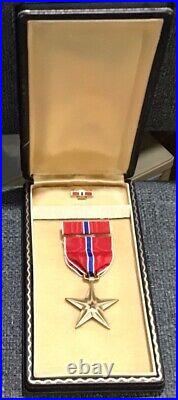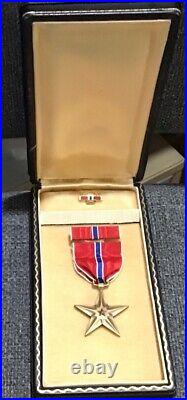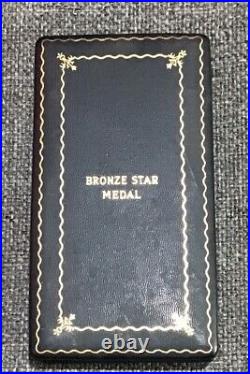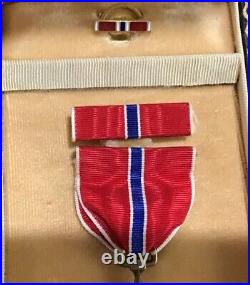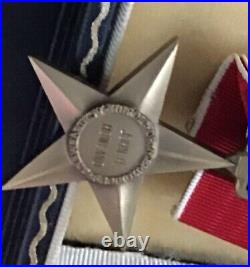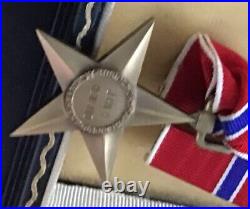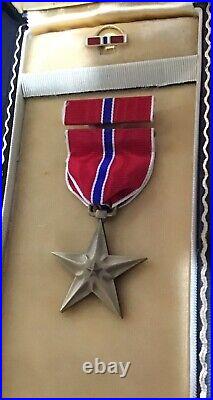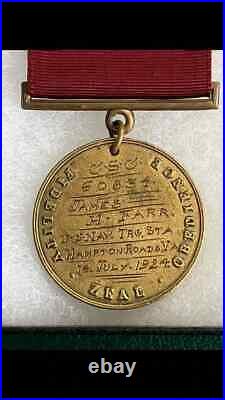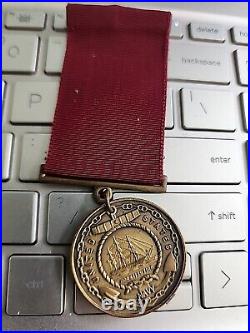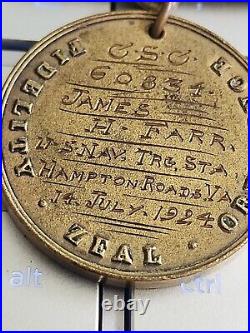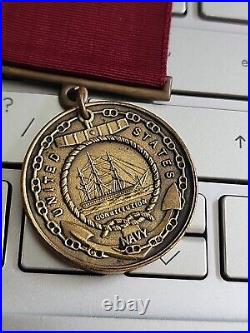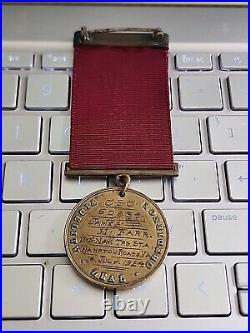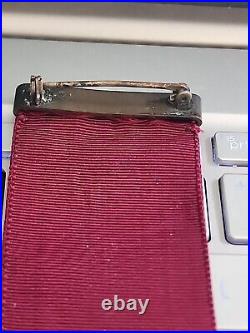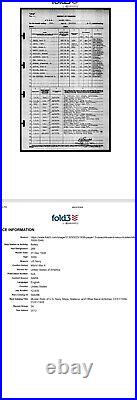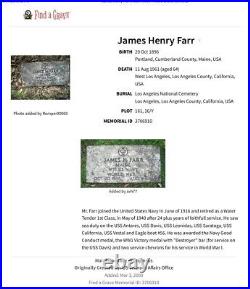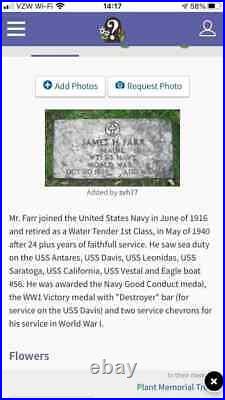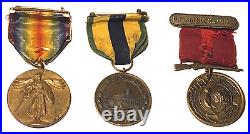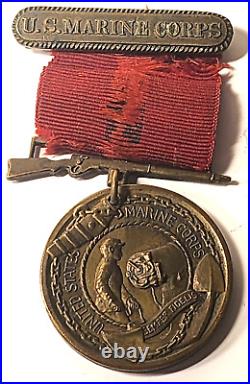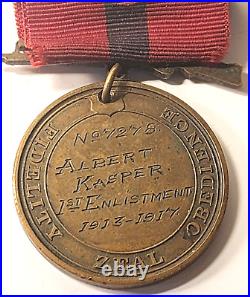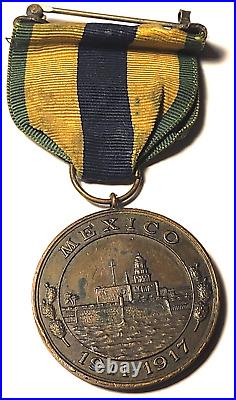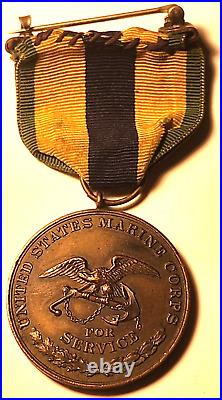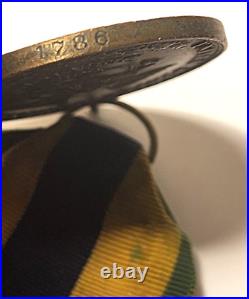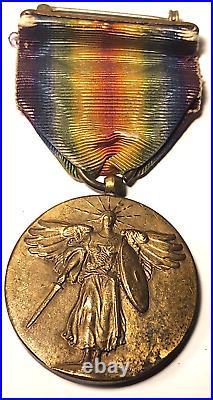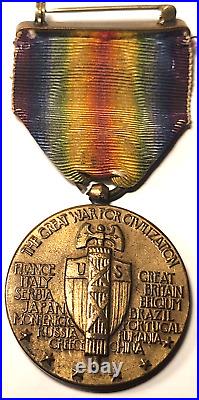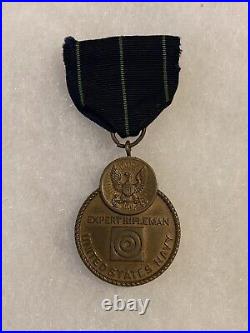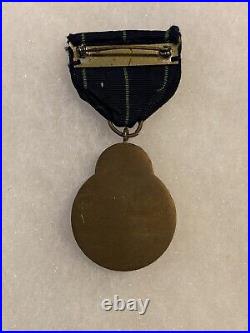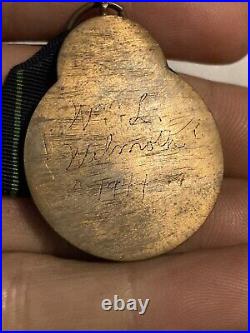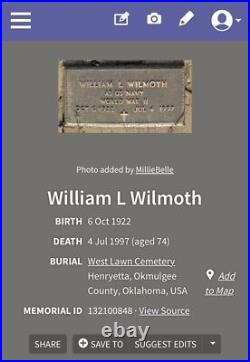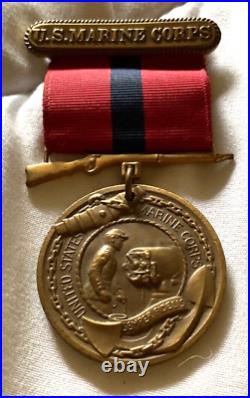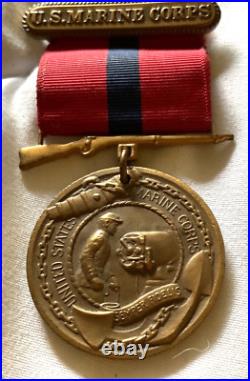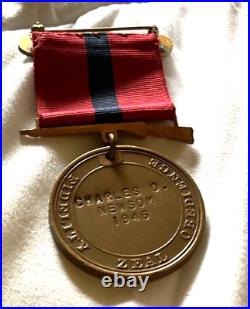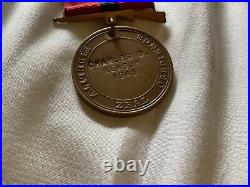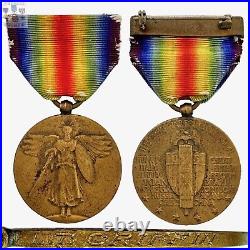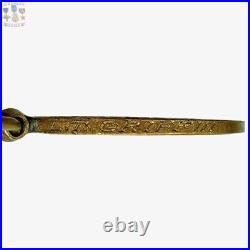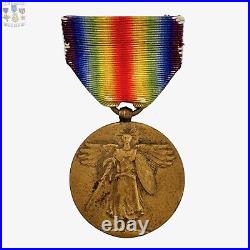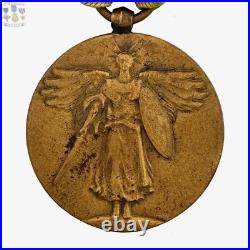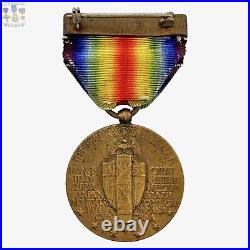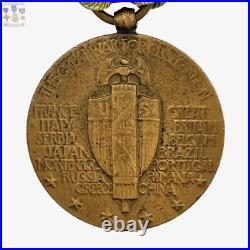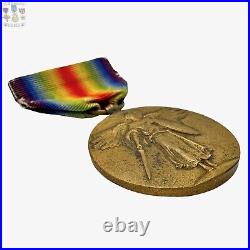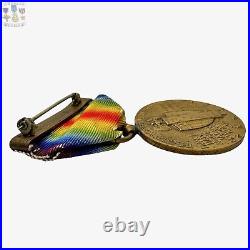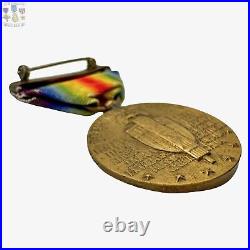Posts tagged engraved
On February 23, 1944 he was on the crew of the B-24 Liberator #42-52107 “The Temptress” when they crashed on takeoff due to engine failure. Their full bomb load was salvoed directly beneath them with several blowing up. This resulted in complete damage to the aircraft and killing all crewmen in the subsequent crash near the town of Fragagnano, Italy.
PLEASE FOLLOW OUR E BAY STORE. PLEASE READ WHOLE ADD. We do not want your feed back. We want your repeat business. We get by having best prices on the net. Sub badge has sub hull number on it, very RARE!! Banner is apx 30 inch’s. First patrol, October 1943 – January 1944. Cod arrived in Brisbane, Australia, on 2 October 1943 to prepare for her first war patrol. She sailed from there 20 days later. Penetrating the South China Sea, she contacted few targets, and launched an attack only once, on 29 November, with unobserved results. Second patrol, February 1944 – March 1944. Cod put to sea for her second war patrol in the South China Sea, off Java, and off Halmahera. On 16 February, she surfaced to sink a sampan by gunfire, and on 23 February, torpedoed a Japanese merchantman. Third patrol, March 1944 – June 1944. Refitting at Fremantle again from 13 March – 6 April 1944, Cod sailed to the Sulu Sea and the South China Sea off Luzon for her third war patrol. Fourth patrol, July 1944 – August 1944. Cod was put to sea again 3 July on her fourth war patrol. She ranged from the coast of Luzon to Java. Fifth patrol, September 1944 – November 1944. Cod put to sea on her fifth war patrol 18 September 1944, bound for Philippine waters. Two days later, she inflicted heavy damage on a tanker. Contacting a large convoy on 25 October, Cod launched several attacks without success. With all her torpedoes expended, she continued to shadow the convoy for another day to report its position. In November she took up a lifeguard station off Luzon, ready to rescue carrier pilots carrying out the series of air strikes on Japanese bases which paved the way for the Battle of Leyte later that month. Sixth patrol, March 1945 – May 1945. On 24 March she sailed from Pearl Harbor for the East China Sea on her sixth war patrol. Assigned primarily to lifeguard duty, she used her deck gun to sink a tugboat and its tow on 17 April, rescuing three survivors, and on 24 April launched an attack on a convoy which resulted in the most severe depth charging of her career. The next day, she sent the minesweeper W-41 to the bottom. Foley and S1c Andrew G. Johnson were washed overboard while freeing the torpedo room hatch. S1c Foley was recovered the next morning, but QM2c Johnson drowned during the night. This was Cod’s only fatality during World War II. Seventh patrol, May 1945 – June 1946. O-19 stuck on Ladd Reef. After refitting at Guam between 29 May and 26 June 1945, Cod put out for the Gulf of Siam and the coast of Indo-China on her seventh war patrol. On 9 and 10 July she went to the rescue of a grounded Dutch submarine, O-19, taking its crew on board and destroying the Dutch submarine when it could not be gotten off the reef. This was the only international submarine-to-submarine rescue in history. After returning the Dutch sailors to U. Naval Base Subic Bay, between 21 July and 1 August Cod made 20 gunfire attacks on the junks, motor sampans, and barges which were all that remained to supply the Japanese at Singapore. After inspecting each contact to rescue civilian crew, Cod sank it by gunfire and torpedoes, sending to the bottom a total of 23. On 1 August, an enemy plane strafed Cod, forcing her to dive, leaving one of her boarding parties behind. The men were rescued two days later by USS Blenny (SS-324). During that celebration, the two crews learned of the Japanese surrender. To symbolize that moment, another symbol was added to Cod’s battle flag: the name O-19 under a martini glass. Cod sailed for home on 31 August. Arriving at Naval Submarine Base New London, on 3 November after a visit to Miami, Florida, Cod sailed to the Philadelphia Navy Yard for a overhaul, returning to New London, Connecticut where she was decommissioned and placed in reserve 22 June 1946. AGSS-224, 1 December 1962, IXSS-224, 30 June 1971. For her successful World War II. Since 1 May 1976. 1,525 long tons (1,549 t) surfaced. 2,424 long tons (2,463 t) submerged. 27 ft 3 in (8.31 m). 17 ft (5.2 m) maximum. 4 × General Motors. 2 × 126- cell. 4 × high-speed General Electric. 2,740 shp (2.0 MW) submerged. 11,000 nautical miles (13,000 mi) surfaced at 10 kn (12 mph). 48 hours at 2 kn (2.3 mph) submerged. 75 days on patrol. 6 officers, 54 enlisted. 10 × 21 inch (533 mm). (6 bow, 4 stern). 1 × 4/50 caliber gun. Later 1 x 5/25 caliber gun. And 20 mm Oerlikon. The Asiatic-Pacific Campaign Medal[1] was a United States military award of the Second World War, which was awarded to any member of the United States Armed Forces who served in the Asiatic-Pacific Theater from 1941 to 1945. The medal was created on November 6, 1942, by Executive Order 9265[2] issued by President Franklin D. The medal was designed by Thomas Hudson Jones; the reverse side was designed by Adolph Alexander Weinman which is the same design as used on the reverse of the American Campaign Medal and European-African-Middle Eastern Campaign Medal. There were 21 Army and 48 Navy-Marine Corps official campaigns of the Pacific Theater, denoted on the suspension and service ribbon of the medal by service stars which also were called “battle stars”; some Navy construction battalion units issued the medal with Arabic numerals. The Arrowhead device is authorized for those campaigns which involved participation in amphibious assault landings. The Fleet Marine Force Combat Operation Insignia is also authorized for wear on the medal for Navy service members who participated in combat while assigned to a Marine Corps unit. The flag colors of the United States and Japan are visible in the ribbon. The Asiatic-Pacific Campaign Medal was first issued as a service ribbon in 1942. A full medal was authorized in 1947, the first of which was presented to General of the Army Douglas MacArthur. The European Theater equivalent of the medal was known as the European-African-Middle Eastern Campaign Medal. Boundaries of Asiatic-Pacific Theater. (1) The eastern boundary is coincident with the western boundary of the American Theater. (2) The western boundary is from the North Pole south along the 60th meridian east longitude to its intersection with the east boundary of Iran, then south along the Iran boundary to the Gulf of Oman and the intersection of the 60th meridian east longitude, then south along the 60th meridian east longitude to the South Pole. US Navy – Marine Corps campaigns. The 43 officially recognized US Navy campaigns in the Pacific Theater of Operations are:[5]. Pearl Harbor: Pearl Harbor-Midway: 7 December 1941. Wake Island: 8-23 December 1941. Philippine Islands operation: 8 December 1941 – 6 May 1942. Netherlands East Indies engagements: 23 January – 27 February 1942. Pacific raids (1942): 1 February – 10 March 1942. Coral Sea: 4-8 May 1942. Midway: 3-6 June 1942. Guadalcanal-Tulagi landings: 7-9 August 1942 (First Savo). Capture and defense of Guadalcanal: 10 August 1942 – 8 February 1943. Makin Raid: 17-18 August 1942. Eastern Solomons: 23-25 August 1942. Buin-Faisi-Tonolai raid: 5 October 1942. Cape Esperance: 11-12 October 1942 (Second Savo). Santa Cruz Islands: 26 October 1942. Guadalcanal: 12-15 November 1942 (Third Savo). Tassafaronga: 30 November – 1 December 1942 (Fourth Savo). Eastern New Guinea operation: 17 December 1942 – 24 July 1944. Rennel Island: 29-30 January 1943. Consolidation of Solomon Islands: 8 February 1943 – 15 March 1945. Aleutians operation: 26 March – 2 June 1943. New Georgia Group operation: 20 June – 16 October 1943. Bismarck Archipelago operation: 25 June 1943 – 1 May 1944. Pacific raids (1943): 31 August – 6 October 1943. Treasury-Bougainville operation: 27 October – 15 December 1943. Gilbert Islands operation: 13 November – 8 December 1943. Marshall Islands operation: 26 November 1943 – 2 March 1944. Asiatic-Pacific raids (1944): 16 February – 9 October 1944. Western New Guinea operations: 21 April 1944 – 9 January 1945. Marianas operation: 10 June – 27 August 1944. Western Caroline Islands operation: 31 August – 14 October 1944. Leyte operation: 10 October – 29 November 1944. Luzon operation: 12 December 1944 – 1 April 1945. Iwo Jima operation 15 February – 16 March 1945. Okinawa Gunto operation: 17 March – 30 June 1945. Third Fleet operations against Japan: 10 July – 15 August 1945. Kurile Islands operation: 1 February 1944 – 11 August 1945. Borneo operations: 27 April – 20 July 1945. Tinian capture and occupation: 24 July – 1 August 1944. Consolidation of the Southern Philippines: 28 February – 20 July 1945. Hollandia operation: 21 April – 1 June 1944. Manila Bay-Bicol operations: 29 January – 16 April 1945. Escort, antisubmarine, armed guard and special operations: 7 December 1941 – 2 September 1945. Submarine War Patrols (Pacific): 7 December 1941 – 2 September 1945.
This Marine medal with the low number 4171 was awarded to George H. Lienneman for good conduct during his four-year enlistment period from 1909 to 1913. All of the engraving on the back is by hand. I nearly overlooked this because it’s so neatly done, but, as you can see, each letter is unique. The Marine Corps Good Conduct Medal was established in 1896 in the design seen here with a ribbon and medal suspended from a clasp bearing the words U. After 1935, that clasp was eliminated. The name of the recipient, the number of the issue and the dates of service were hand engraved until World War II when the medals began to be numbered on the rim and the name, etc…
This is an extremely fine World War II U. Air Medal awarded to 1st Lt. Hamlen, 77th Infantry Division that is excellent condition. The planchet is with a beautiful satin bronze finish to both sides. The reverse is officially hand engraved in six lines with,’1st Lt. Hamlen – 77 Inf. It is suspended from the original ribbon which is solid and with vibrant color. The medal is mounted on the correct WWI type slot broach that is complete with functional pin assembly. It remains an absolutely gorgeous 6-line engraved medal in excellent condition.
PLEASE FOLLOW OUR E BAY STORE. SALE SEE OUR STORE. PLEASE READ WHOLE ADD. Further information: Washington Naval Conference. And USS Panay incident. At the end of World War I, the United States Navy had almost 500,000 officers and enlisted men and women and in terms of personnel was the largest in the world. Younger officers were enthusiastic about the potential of land-based naval aviation as well as the potential roles of aircraft carriers. Chief of Naval Operations Benson was not among them. He tried to abolish aviation in 1919 because he could not conceive of any use the fleet will ever have for aviation. However Roosevelt listened to the visionaries and reversed Benson’s decision. The US Navy’s first aircraft carrier. American isolationist feeling and the economic concerns of the others led to the Washington Naval Conference. The outcome of the conference included the Washington Naval Treaty. (also known as the Five-Power treaty), and limitations on the use of submarines. The treaty recognized the U. One consequence was to encourage the development of light cruisers. The United States’s first carrier, a converted collier. Was commissioned in 1922, and soon joined by USS Lexington. Which had been designed as battlecruisers. Until the treaty forbade it. Organizationally, the Bureau of Aeronautics. Was formed in 1921; naval aviators would become referred to as members of the United States Naval Air Corps. Army airman Billy Mitchell. Challenged the Navy by trying to demonstrate that warships could be destroyed by land-based bombers. He destroyed his career in 1925 by publicly attacking senior leaders in the Army and Navy for incompetence for their almost treasonable administration of the national defense. Chief of Naval Operations William V. Emphasis on disarmament and went along with postponement of new construction and cutting the fleet. Other naval officers disagreed sharply with Hoover’s policies. Had been in effect in civilian control of the Navy during World War I, knew many senior officers, and strongly supported naval expansion. The Navy’s preparation was helped along by another Navy assistant secretary turned president, Franklin D. The naval limitation treaties also applied to bases, but Congress only approved building seaplane bases on Wake Island. And rejected any additional funds for bases on Guam and the Philippines. The Navy had a presence in the Far East with a naval base in the US-owned Philippines and river gunboats in China on the Yangtze River. The gunboat USS Panay. Was bombed and machine-gunned by Japanese airplanes. Washington quickly accepted Japan’s apologies and compensation. African-Americans were enlisted during World War I, but this was halted in 1919 and they were mustered out of the Navy. Starting in the 1930s a few were recruited to serve as stewards in the officers mess. African-Americans were recruited in larger numbers only after Roosevelt insisted in 1942. The Naval Act of 1936. Authorized the first new battleship since 1921, and USS North Carolina. Was laid down in October 1937. The Second Vinson Act. Authorized a 20% increase in the size of the Navy, and in June 1940 the Two-Ocean Navy Act. Authorized an 11% expansion in the Navy. Chief of Naval Operations. In September 1940, the Destroyers for Bases Agreement. In 1941, the Atlantic Fleet. The Navy’s first shot in anger came on April 9, when the destroyer USS Niblack. Dropped depth charges on a U-boat detected while Niblack was rescuing survivors from a torpedoed Dutch freighter. In October, the destroyers Kearny. Were torpedoed, and Reuben James was lost. Submarines were the “silent service”-in terms of operating characteristics and the closed-mouth preferences of the submariners. Strategists had, however, been looking into this new type of warship, influenced in large part by Germany’s nearly successful U-boat campaign. As early as 1912, Lieutenant Chester Nimitz had argued for long-range submarines to accompany the fleet to scout the enemy’s location. The new head of the Submarine Section in 1919 was Captain Thomas Hart, who argued that submarines could win the next war: There is no quicker or more effective method of defeating Japan than the cutting of her sea communications. However Hart was astonished to discover how backward American submarines were compared to captured German U-boats, and how unready they were for their mission. The public supported submarines for their coastal protection mission; they would presumably intercept enemy fleets approaching San Francisco or New York. The Navy realized it was a mission that isolationists in Congress would fund, but it was not actually serious. Old-line admirals said the mission of the subs ought to be as eyes of the battle fleet, and as assistants in battle. That was unfeasible since even on the surface submarines could not move faster than 20 knots, far slower than the 30 knot main warships. The young commanders were organized into a “Submarine Officers’ Conference” in 1926. They argued they were best suited for the commerce raiding that had been the forte of the U-boats. They therefore redesigned their new boats along German lines, and added the new requirement that they be capable of sailing alone for 7,500 miles on a 75-day mission. Unrestricted submarine warfare had led to war with Germany in 1917, and was still vigorously condemned both by public opinion and by treaties, including the London Treaty of 1930. The Navy kept its plans secret from civilians. The challenge of designing appropriate new boats became a high priority by 1934, and was solved in 1936 as the first new long-range, all welded submarines were launched. Even better were the S-class Salmon class. (launched in 1937), and its successors the T-class or Tambor submarines. Of 1939 and the Gato class of 1940. At 300 feet in length and 1500 tons, they were twice as big as the German U-boats, but still highly maneuverable. In only 35 seconds they could crash dive to 60 feet. The superb Mark 3 TDC Torpedo Data Computer (an analog computer) took data from periscope or sonar readings on the target’s bearing, range and angle on the bow, and continuously set the course and proper gyroscope angle for a salvo of torpedoes until the moment of firing. Six forward tubes and 4 aft were ready for the 24 Mk-14 “fish” the subs carried. New steels and welding techniques strengthened the hull, enabling the subs to dive as deep as 400 feet in order to avoid depth charges. Expecting long cruises the 65 crewmen enjoyed good living conditions, complete with frozen steaks and air conditioning to handle the hot waters of the Pacific. The new subs could remain at sea for 75 days, and cover 10,000 miles, without resupply. The submariners thought they were ready-but they had two hidden flaws. The penny-pinching atmosphere of the 1930s produced hypercautious commanders and defective torpedoes. Both would have to be replaced in World War II.
These medals have some wear from normal use. The ribbon on the Good Conduct Medal is frayed. It is numbered NO. The Mexico Service Medal is numbered 1786 on the rim. (See photos for details) Additional photos available upon request. Please specify details you would like to see more clearly. Most items not sent internationally.
ORIGINAL WORLD WAR I UNITED STATES NAVAL VICTORY MEDAL W/ FULL WRAP BROOCH. RIBBON DRAPE TESTED U. The World War I Victory Medal is a service medal of the United States military which was first created in 1919, designed by James Earle Fraser. The medal was originally intended to be created due to an act of the United States Congress, however the bill authorizing the medal never passed, leaving the service departments to create the award through general orders. The United States Army published orders authorizing the World War I Victory Medal in April 1919 and the U. Navy followed in June of that same year. Known until 1947 simply as the “Victory Medal”, the World War I Victory Medal was awarded to any member of the U. Military who had served in the armed forces between the following dates in the following locations. 6 April 1917 to 11 November 1918 for any military service. 12 November 1918, to 5 August 1919 for service in European Russia. 23 November 1918, to 1 April 1920 for service with the American Expeditionary Force Siberia. The front of the bronze medal features a winged Victory holding a shield and sword on the front. The back of the bronze medal features “The Great War For Civilization” in all capital letters curved along the top of the medal. Curved along the bottom of the back of the medal are six stars, three on either side of the center column of seven staffs wrapped in a cord. The top of the staff has a round ball on top and is winged on the side. The staff is on top of a shield that says “U” on the left side of the staff and “S” on the right side of the staff. On left side of the staff it lists one World War I Allied country per line: France, Italy, Serbia, Japan, Montenegro, Russia, and Greece. On the right side of the staff the Allied country names read: Great Britain, Belgium, Brazil, Portugal, Rumania (spelled with a U instead of an O as it is spelled now), and China. Please let me know if there’s anything else I can do for you!



















